Effects of Wide Bandgap Devices on the Inverter Performance and Efficiency for Residential PV Applications
Abstract
1. Introduction
2. Power Inverter for Grid-Connected PV System
2.1. PV System
2.2. Power Inverter
3. Inverter Power Loss Analysis
3.1. Conduction Loss
3.2. Switching Energy Loss
3.3. Total Power Loss of the Inverter
4. Experimental Setup
5. Switching Device Characterization and Switching Energy Loss Evaluation
5.1. 900 V Si-IGBT Switching Performance
5.2. 900 V SiC-MOSFET Switching Performance
5.3. Switching Energy Losses
5.3.1. Switching Losses with Different Switch Currents
5.3.2. Energy Losses with Different Gate Resistances
5.3.3. Switching Losses with Different Input Voltages
6. Inverter Performance Evaluation
6.1. Inverter Evaluation as Increasing Switching Frequency
6.2. Inverter Evaluation as Increasing Input Voltage
7. Conclusions
Author Contributions
Funding
Institutional Review Board Statement
Informed Consent Statement
Data Availability Statement
Conflicts of Interest
References
- Alluhaybi, K.; Batarseh, I.; Hu, H. Comprehensive Review and Comparison of Single-Phase Grid-Tied Photovoltaic Microinverters. IEEE J. Emerg. Sel. Top. Power Electron. 2020, 8, 1310–1329. [Google Scholar] [CrossRef]
- Kjaer, S.B.; Pedersen, J.K.; Blaabjerg, F. A review of single-phase grid-connected inverters for photovoltaic modules. IEEE Trans. Ind. Appl. 2005, 41, 1292–1306. [Google Scholar] [CrossRef]
- International Energy Agency (IEA). Tracking SDG7: The Energy Progress Report. 2021. Available online: https://www.iea.org/reports/tracking-sdg7-the-energy-progress-report-2021 (accessed on 8 October 2024).
- SolarPower Europe. Global Market Outlook for Solar Power 2024–2028. 2024. Available online: https://www.solarpowereurope.org/insights/outlooks/global-market-outlook-for-solar-power-2024-2028 (accessed on 9 October 2024).
- Haque, M.M.; Wolfs, P.J.; Alahakoon, S.; Islam, M.A.; Nadarajah, M.; Zare, F.; Farrok, O. Three-Port Converters for Energy Conversion of PV-BES Integrated Systems—A Review. IEEE Access 2023, 11, 6551–6573. [Google Scholar] [CrossRef]
- Bhattacharjee, A.K.; Kutkut, N.; Batarseh, I. Review of Multiport Converters for Solar and Energy Storage Integration. IEEE Trans. Power Electron. 2019, 34, 1431–1445. [Google Scholar] [CrossRef]
- Abdel-Rahim, O.; Chub, A.; Vinnikov, D.; Blinov, A. DC Integration of Residential Photovoltaic Systems: A Survey. IEEE Access 2022, 10, 66974–66991. [Google Scholar] [CrossRef]
- Xue, Y.; Chang, L.; Kjaer, S.B.; Bordonau, J.; Shimizu, T. Topologies of single-phase inverters for small distributed power generators: An overview. IEEE Trans. Power Electron. 2004, 19, 1305–1314. [Google Scholar] [CrossRef]
- Tang, Z.; Yang, Y.; Blaabjerg, F. Power electronics: The enabling technology for renewable energy integration. CSEE J. Power Energy Syst. 2022, 8, 39–52. [Google Scholar] [CrossRef]
- Maurya, J.; Saket, R.K.; Srivastava, R.K. Performance Analysis of Single-Stage and Two-Stage VSI-Fed Induction Motor Drives for Solar Water Pumping Applications. IEEE Trans. Ind. Appl. 2024, 60, 8856–8866. [Google Scholar] [CrossRef]
- Pal, A.; Basu, K. A Soft-Switched High-Frequency Link Single-Stage Three-Phase Inverter for Grid Integration of Utility Scale Renewables. IEEE Trans. Power Electron. 2019, 34, 8513–8527. [Google Scholar] [CrossRef]
- Bairami, S.; Salimi, M.; Mirabbasi, D. A Novel Method for Maximum Power Point Tracking of the Grid-Connected Three-Phase Solar Systems Based on the PV Current Prediction. Chin. J. Electron. 2023, 32, 353–364. [Google Scholar] [CrossRef]
- Ibrahim, N.F.; Mahmoud, K.; Lehtonen, M.; Darwish, M.M.F. Comparative Analysis of Three-Phase PV Grid Connected Inverter Current Control Schemes in Unbalanced Grid Conditions. IEEE Access 2023, 11, 42204–42221. [Google Scholar] [CrossRef]
- Kim, M.; Yun, H.-J. A Basic Design Tool for Grid-Connected AC–DC Converters Using Silcon Carbide MOSFETs. Electronics 2023, 12, 4828. [Google Scholar] [CrossRef]
- Sajadian, S.; Ahmadi, R. Model Predictive-Based Maximum Power Point Tracking for Grid-Tied Photovoltaic Applications Using a Z-Source Inverter. IEEE Trans. Power Electron. 2016, 31, 7611–7620. [Google Scholar] [CrossRef]
- Yazdani, S.; Ferdowsi, M.; Davari, M.; Shamsi, P. Advanced Current-Limiting and Power-Sharing Control in a PV-Based Grid-Forming Inverter Under Unbalanced Grid Conditions. IEEE J. Emerg. Sel. Top. Power Electron. 2020, 8, 1084–1096. [Google Scholar] [CrossRef]
- Costa, P.; Pinto, S.; Silva, J.F. A Novel Analytical Formulation of SiC-MOSFET Losses to Size High-Efficiency Three-Phase Inverters. Energies 2023, 16, 818. [Google Scholar] [CrossRef]
- Rujas, A.; Landaburu, I.; Lopez-Martin, V.M.; Barambones, O. Magnetic Design of a 3-Phase SiC-Based PV Inverter with DC-Link Referenced Output Filter. IEEE Access 2023, 11, 25531–25542. [Google Scholar] [CrossRef]
- Stepenko, S.; Husev, O.; Vinnikov, D.; Roncero-Clemente, C.; Pires Pimentel, S.; Santasheva, E. Experimental Comparison of Two-Level Full-SiC and Three-Level Si–SiC Quasi-Z-Source Inverters for PV Applications. Energies 2019, 12, 2509. [Google Scholar] [CrossRef]
- Marzoughi, A.; Burgos, R.; Boroyevich, D. Characterization and Performance Evaluation of the State-of-the-Art 3.3 kV 30 A Full-SiC MOSFETs. IEEE Trans. Ind. Appl. 2019, 55, 575–583. [Google Scholar] [CrossRef]
- Fuentes, C.D.; Müller, M.; Bernet, S.; Kouro, S. SiC-MOSFET or Si-IGBT: Comparison of Design and Key Characteristics of a 690 V Grid-Tied Industrial Two-Level Voltage Source Converter. Energies 2021, 14, 3054. [Google Scholar] [CrossRef]
- Wang, Y.; Chen, M.; Xu, D. Design of Low Inductance SiC MOS/Si-IGBT Hybrid Module for PV Inverters. IEEE Open J. Power Electron. 2022, 3, 942–954. [Google Scholar] [CrossRef]
- Chakraborty, R.; Eskilson, T.; Biswas, S.; Makoschitz, M. A Comparative Analysis of Efficiency and Losses in a 5 kW Hybrid and Full-SiC Converter, for PV Applications in Austria. Energies 2024, 17, 5600. [Google Scholar] [CrossRef]
- Khodabandeh, M.; Afshari, E.; Amirabadi, M. A Single-Stage Soft-Switching High-Frequency AC-Link PV Inverter: Design, Analysis, and Evaluation of Si-Based and SiC-Based Prototypes. IEEE Trans. Power Electron. 2019, 34, 2312–2326. [Google Scholar] [CrossRef]
- Loncarski, J.; Monopoli, V.G.; Leuzzi, R.; Ristic, L.; Cupertino, F. Analytical and Simulation Fair Comparison of Three Level Si IGBT Based NPC Topologies and Two Level SiC MOSFET Based Topology for High Speed Drives. Energies 2019, 12, 4571. [Google Scholar] [CrossRef]
- Woldegiorgis, D.; Mantooth, H.A. Precise Electro-thermal Power Loss Model of a Three-level ANPC Inverter with Hybrid Si/SiC Switches. Chin. J. Electr. Eng. 2022, 8, 76–89. [Google Scholar] [CrossRef]
- Liu, H.; Zhao, T.; Wu, X. Performance Evaluation of Si/SiC Hybrid Switch-Based Three-Level Active Neutral-Point-Clamped Inverter. IEEE Open J. Ind. Appl. 2022, 3, 90–103. [Google Scholar] [CrossRef]
- Wang, K.; Ma, D.; Hu, B.; Wang, J.; Singh, A.; Mather, B. Hardware Design of Medium Voltage SiC-based Modular Multilevel Converters for Grid-tied Applications. In Proceedings of the 2021 IEEE 8th Workshop on Wide Bandgap Power Devices and Applications (WiPDA), Redondo Beach, CA, USA, 7–11 November 2021; pp. 339–344. [Google Scholar] [CrossRef]
- Haghighian, S.K.; Yeh, H.G.; Marangalu, M.G.; Kurdkandi, N.V.; Abbasi, M.; Tarzamni, H. A Seventeen-Level Step-Up Switched-Capacitor-Based Multilevel Inverter with Reduced Charging Current Stress on Capacitors for PV Applications. IEEE Access 2023, 11, 118124–118143. [Google Scholar] [CrossRef]
- Kala, P.; Jately, V.; Sharma, A.; Joshi, J.; Azzopardi, B. ASO-Based SHE Method on Hybrid Multilevel Inverter for PV Application Under Dynamic Operating Conditions. IEEE Access 2023, 11, 98093–98114. [Google Scholar] [CrossRef]
- Marques, G.D.; Cruz, S.M.A.; Iacchetti, M.F. Minimum-Loss Control Strategy for a Dual-VSI DFIG DC System. IEEE Trans. Ind. Electron. 2020, 67, 8175–8185. [Google Scholar] [CrossRef]
- Wang, Y.; Li, H.; Liu, R.; Yang, L.; Wang, X. Modulated Model-Free Predictive Control with Minimum Switching Losses for PMSM Drive System. IEEE Access 2020, 8, 20942–20953. [Google Scholar] [CrossRef]
- Kumar, A.; Moradpour, M.; Losito, M.; Franke, W.-T.; Ramasamy, S.; Baccoli, R.; Gatto, G. Wide Band Gap Devices and Their Application in Power Electronics. Energies 2022, 15, 9172. [Google Scholar] [CrossRef]
- Chaudhary, O.S.; Denaï, M.; Refaat, S.S.; Pissanidis, G. Technology and Applications of Wide Bandgap Semiconductor Materials: Current State and Future Trends. Energies 2023, 16, 6689. [Google Scholar] [CrossRef]
- Buffolo, M.; Favero, D.; Marcuzzi, A.; Santi, C.D.; Meneghesso, G.; Zanoni, E.; Meneghini, M. Review and Outlook on GaN and SiC Power Devices: Industrial State-of-the-Art, Applications, and Perspectives. IEEE Trans. Electron. Devices 2024, 71, 1344–1355. [Google Scholar] [CrossRef]
- Ballestín-Fuertes, J.; Muñoz-Cruzado-Alba, J.; Sanz-Osorio, J.F.; Laporta-Puyal, E. Role of Wide Bandgap Materials in Power Electronics for Smart Grids Applications. Electronics 2021, 10, 677. [Google Scholar] [CrossRef]
- Zhang, B.; Wang, S. A Survey of EMI Research in Power Electronics Systems With Wide-Bandgap Semiconductor Devices. IEEE J. Emerg. Sel. Top. Power Electron. 2020, 8, 626–643. [Google Scholar] [CrossRef]
- DiMarino, C.M.; Burgos, R.; Dushan, B. High-temperature silicon carbide:characterization of state-of-the-art silicon carbide power transistors. IEEE Ind. Electron. Mag. 2015, 9, 19–30. [Google Scholar] [CrossRef]
- Alharbi, S.S.; Matin, M. Experimental evaluation of medium-voltage cascode gallium nitride (GaN) devices for bidirectional DC-DC converters. CES Trans. Elect. Mach. Syst. 2021, 5, 232–248. [Google Scholar] [CrossRef]
- Iannaccone, G.; Sbrana, C.; Morelli, I.; Strangio, S. Power Electronics Based on Wide-Bandgap Semiconductors: Opportunities and Challenges. IEEE Access 2021, 9, 139446–139456. [Google Scholar] [CrossRef]
- Bindra, A. Wide-Bandgap-Based Power Devices: Reshaping the power electronics landscape. IEEE Power Electron. Mag. 2015, 2, 42–47. [Google Scholar] [CrossRef]
- Wang, Y.; Ding, Y.; Yin, Y. Reliability of Wide Band Gap Power Electronic Semiconductor and Packaging: A Review. Energies 2022, 15, 6670. [Google Scholar] [CrossRef]
- Cunningham, D.W.; Carlson, E.P.; Manser, J.S.; Kizilyalli, I.C. Impacts of Wide Band Gap Power Electronics on Photovoltaic System Design. IEEE J. Photovoltaics 2020, 10, 213–218. [Google Scholar] [CrossRef]
- Shi, Y.; Li, H.; Wang, L.; Zhang, Y. Intercell Transformer (ICT) Design Optimization and Interphase Crosstalk Mitigation of a 100-kW SiC Filter-Less Grid-Connected PV String Inverter. IEEE Open J. Power Electron. 2020, 10, 51–63. [Google Scholar] [CrossRef]
- Narasimhan, S.; Kanale, A.; Bhattacharya, S.; Baliga, J.B. Performance Evaluation of 3.3 kV SiC MOSFET and Schottky Diode Based Reverse Voltage Blocking Switch for Medium Voltage Current Source Inverter Application. IEEE Access 2020, 10, 89277–89289. [Google Scholar] [CrossRef]
- Acharya, S.; She, X.; Tao, F.; Frangieh, T.; Todorovic, M.H.; Datta, R. Active Gate Driver for SiC-MOSFET-Based PV Inverter With Enhanced Operating Range. IEEE Trans. Ind. Appl. 2010, 55, 1677–1689. [Google Scholar] [CrossRef]
- Yin, T.; Xu, C.; Lin, L.; Jing, K. A SiC MOSFET and Si IGBT Hybrid Modular Multilevel Converter with Specialized Modulation Scheme. IEEE Trans. Power Electron. 2020, 35, 12623–12628. [Google Scholar] [CrossRef]
- Kang, Z.; Xie, X.; Liu, Y.; Chen, D.; Yuan, H.; Zhao, L.; Zhao, H.; Yang, C.; Zheng, G. A High-Voltage Pulse Modulator Composed of SiC MOSFETs/IGBTs in a Hybrid Connecting State. Electronics 2024, 13, 2108. [Google Scholar] [CrossRef]
- Huang, J.; Wang, Y.; Li, Z.; Zhu, H.; Li, K. A Si IGBT/SiC MOSFET Hybrid Isolated Bidirectional DC–DC Converter for Reducing Losses and Costs of DC Solid State Transformer. Electronics 2024, 13, 801. [Google Scholar] [CrossRef]
- Hazra, S.; De, A.; Cheng, L.; Palmour, J.; Schupbach, M.; Hull, B.A.; Allen, S.; Bhattacharya, S. High Switching Performance of 1700-V, 50-A SiC Power MOSFET Over Si IGBT/BiMOSFET for Advanced Power Conversion Applications. IEEE Trans. Power Electron. 2016, 31, 4742–4754. [Google Scholar] [CrossRef]
- Yin, S.; Wu, Y.; Liu, Y.; Pan, X. Comparative Design of Gate Drivers with Short-Circuit Protection Scheme for SiC MOSFET and Si IGBT. Energies 2019, 12, 4546. [Google Scholar] [CrossRef]
- Sheikhan, A.; Narayanan, E.M.S. Characteristics of a 1200 V Hybrid Power Switch Comprising a Si IGBT and a SiC MOSFET. Micromachines 2024, 15, 1337. [Google Scholar] [CrossRef]
- Yin, T.; Lin, L.; Xu, C.; Zhu, D.; Jing, K. A Hybrid Modular Multilevel Converter Comprising SiC MOSFET and SiIGBT with Its Specialized Modulation and Voltage Balancing Scheme. IEEE Trans. Ind. Electron. 2022, 11, 11272–11282. [Google Scholar] [CrossRef]
- Zhou, W.; Yuan, X. Experimental Evaluation of SiC Mosfets in Comparison to Si IGBTs in a Soft-Switching Converter. IEEE Trans. Ind. Appl. 2020, 56, 5108–5118. [Google Scholar] [CrossRef]
- Vechalapu, K.; Bhattacharya, S.; Brunt, E.V.; Ryu, S.H.; Grider, D.; Palmour, J.W. Comparative Evaluation of 15-kV SiC MOSFET and 15-kV SiC IGBT for Medium-Voltage Converter Under the Same dv/dt Conditions. IEEE J. Emerg. Sel. Top. Power Electron. 2017, 5, 469–489. [Google Scholar] [CrossRef]
- Burkart, R.M.; Kolar, J.W. Comparative Life Cycle Cost Analysis of Si and SiC PV Converter Systems Based on Advanced η- ρ-σ Multiobjective Optimization Techniques. IEEE Trans. Power Electron. 2017, 32, 4344–4358. [Google Scholar] [CrossRef]
- Chen, H.J.; Kusic, G.L.; Reed, G.F. Comparative PSCAD and Matlab/Simulink simulation models of power losses for SiC MOSFET and Si IGBT devices. In Proceedings of the 2012 IEEE Power and Energy Conference at Illinois, Champaign, IL, USA, 24–25 February 2012; pp. 1–5. [Google Scholar] [CrossRef]
- Öztürk, S.; Canver, M.; Çadırcı, I.; Ermiş, M. All SiC Grid-Connected PV Supply with HF Link MPPT Converter: System Design Methodology and Development of a 20 kHz, 25 kVA Prototype. Electronics 2018, 7, 85. [Google Scholar] [CrossRef]
- Ning, P.; Yuan, T.; Kang, Y.; Han, C.; Li, L. Review of Si IGBT and SiC MOSFET based on hybrid switch. Chin. J. Electr. Eng. 2019, 5, 20–29. [Google Scholar] [CrossRef]
- Xu, C.; He, J.; Lin, L. Research on Capacitor-Switching Semi-Full-Bridge Submodule of Modular Multilevel Converter Using Si IGBT and SiC MOSFET. IEEE J. Emerg. Sel. Top. Power Electron. 2021, 9, 4814–4825. [Google Scholar] [CrossRef]
- Hazra, S.; Madhusoodhanan, S.; Moghaddam, G.K.; Hatua, K.; Bhattacharya, S. Design Considerations and Performance Evaluation of 1200-V 100-A SiC MOSFET-Based Two-Level Voltage Source Converter. IEEE Trans. Ind. Appl. 2016, 52, 4257–4268. [Google Scholar] [CrossRef]
- Mirzaee, H.; De, A.; Tripathi, A.; Bhattacharya, S. Design Comparison of High-Power Medium-Voltage Converters Based on a 6.5-kV Si IGBT/Si-PiN Diode, a 6.5-kV Si IGBT/SiC-JBS Diode, and a 10-kV SiC MOSFET/SiC-JBS Diode. IEEE Trans. Ind. Appl. 2014, 50, 2728–2740. [Google Scholar] [CrossRef]
- Qi, J.; Yang, X.; Li, X.; Tian, K.; Mao, Z.; Yang, S.; Song, W. Temperature Dependence of Dynamic Performance Characterization of 1.2-kV SiCPower mosfets Compared With Si IGBTs for Wide Temperature Applications. IEEE Trans. Power Electron. 2019, 34, 9105–9117. [Google Scholar] [CrossRef]
- Fuentes, C.D.; Kouro, S.; Bernet, S. Comparison of 1700-V SiC-MOSFET and Si-IGBT Modules Under Identical Test Setup Conditions. IEEE Trans. Ind. Appl. 2019, 55, 7765–7775. [Google Scholar] [CrossRef]
- Shah, F.M.; Maqsood, S.; Damaševičius, R.; Blažauskas, T. Disturbance Rejection and Control Design of MVDC Converter with Evaluation of Power Loss and Efficiency Comparison of SiC and Si Based Power Devices. Electronics 2020, 9, 1878. [Google Scholar] [CrossRef]
- Jahan, S.; Biswas, S.P.; Haq, S.; Islam, M.R.; Mahmud, M.A.P.; Kouzani, A.Z. An advanced control scheme for voltage source inverter based grid-tied PV systems. IEEE Trans. Appl. Supercond. 2021, 31, 5401705. [Google Scholar] [CrossRef]
- Assunção, G.d.O.; Barbi, I. Method for deriving transformerless common-ground voltage source inverter topologies. IEEE Trans. Power Electron. 2022, 37, 10821–10832. [Google Scholar] [CrossRef]
- Hu, C.; Yin, Z.; Rui, T.; Zhang, Z.; Shen, W.; Cao, W.; Holmes, D.G. A novel double-voltage-vector model-free predictive current control method for two-level voltage source inverters. IEEE Trans. Ind. Electron. 2023, 70, 5872–5884. [Google Scholar] [CrossRef]
- Ahmed, M.H.; Wang, M.; Hassan, M.A.S.; Ullah, I. Power Loss Model and Efficiency Analysis of Three-Phase Inverter Based on SiC MOSFETs for PV Applications. IEEE Access 2019, 7, 75768–75781. [Google Scholar] [CrossRef]
- Safari, S.; Castellazzi, A.; Wheeler, P. Experimental and Analytical Performance Evaluation of SiC Power Devices in the Matrix Converter. IEEE Trans. Power Electron. 2014, 5, 2584–2596. [Google Scholar] [CrossRef]
- Ding, X.; Chen, F.; Du, M.; Guo, H.; Ren, S. Effects of silicon carbide MOSFETs on the efficiency and power quality of a microgrid-connected inverter. Appl. Energy 2017, 201, 270–283. [Google Scholar] [CrossRef]
- Gurpinar, E.; Castellazzi, A. Single-Phase T-Type Inverter Performance Benchmark Using Si IGBTs, SiC MOSFETs, and GaN HEMTs. IEEE Trans. Power Electron. 2016, 31, 7148–7160. [Google Scholar] [CrossRef]
- Amirpour, S.; Thiringer, T.; Hagstedt, D. Energy Loss Analysis in a SiC/IGBT Propulsion Inverter over Drive Cycles Considering Blanking time, MOSFET’s Reverse Conduction and the Effect of Thermal Feedback. In Proceedings of the 2020 IEEE Energy Conversion Congress and Exposition (ECCE), Detroit, MI, USA, 11–15 October 2020; pp. 1505–1511. [Google Scholar] [CrossRef]
- Dynex Semiconductor Ltd. AN6156–Calculating Power Losses in an IGBT Module. Available online: https://www.dynexsemi.com/Portals/0/assets/downloads/DNX_AN6156.pdf (accessed on 31 October 2024).
- Filipović-Grčić, D.; Filipović-Grčić, B.; Krajtner, D. Frequency response and harmonic distortion testing of inductive voltage transformer used for power quality measurements. In Proceedings of the 4th International Colloquium Transformer Research and Asset Management, Pula, Croatia, 10–12 May 2017; pp. 159–167. [Google Scholar] [CrossRef]
- Alharbi, S.S.; Alharbi, S.S.; Al-bayati, A.M.S.; Matin, M.A. Comparative performance evaluation of Si IGBT, SiC JFET, and SiC MOSFET power devices for a non-isolated DC-DC boost converter. In Proceedings of the 2017 North American Power Symposium (NAPS), Morgantown, WV, USA, 17–19 September 2017; pp. 1–6. [Google Scholar] [CrossRef]
- Havrlík, M.; Libra, M.; Poulek, V.; Kouřím, P. Analysis of Output Signal Distortion of Galvanic Isolation Circuits for Monitoring the Mains Voltage Waveform. Sensors 2022, 22, 7769. [Google Scholar] [CrossRef]
- Marzoughi, A.; Wang, J.; Burgos, R.; Boroyevich, D. Characterization and Evaluation of the State-of-the-Art 3.3-kV 400-A SiC MOSFETs. IEEE Trans. Ind. Electron. 2017, 64, 8247–8257. [Google Scholar] [CrossRef]
- Kranzer, D.; Wilhelm, C.; Reiners, F.; Burger, B. Application of normally-off SiC-JFETs in photovoltaic inverters. In Proceedings of the 2009 13th European Conference on Power Electronics and Applications, Barcelona, Spain, 8–10 September 2009; pp. 1–6. [Google Scholar]
- Villanueva, I.; Vázquez, N.; Vaquero, J.; Hernández, C.; López-Tapia, H.; Osorio-Sánchez, R. Photovoltaic Inverter Reliability Study through SiC Switches Redundant Structures. Technologies 2023, 11, 59. [Google Scholar] [CrossRef]

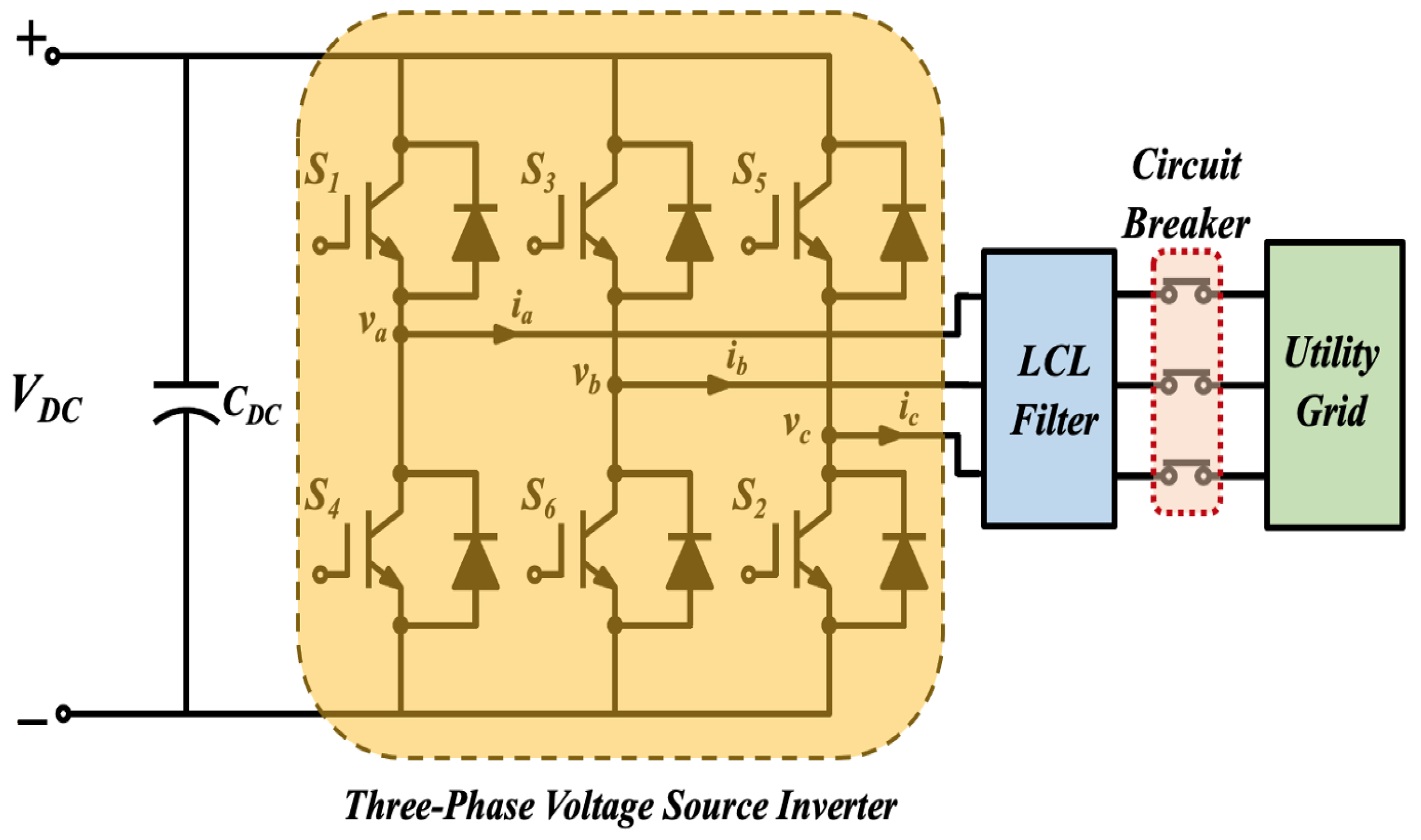

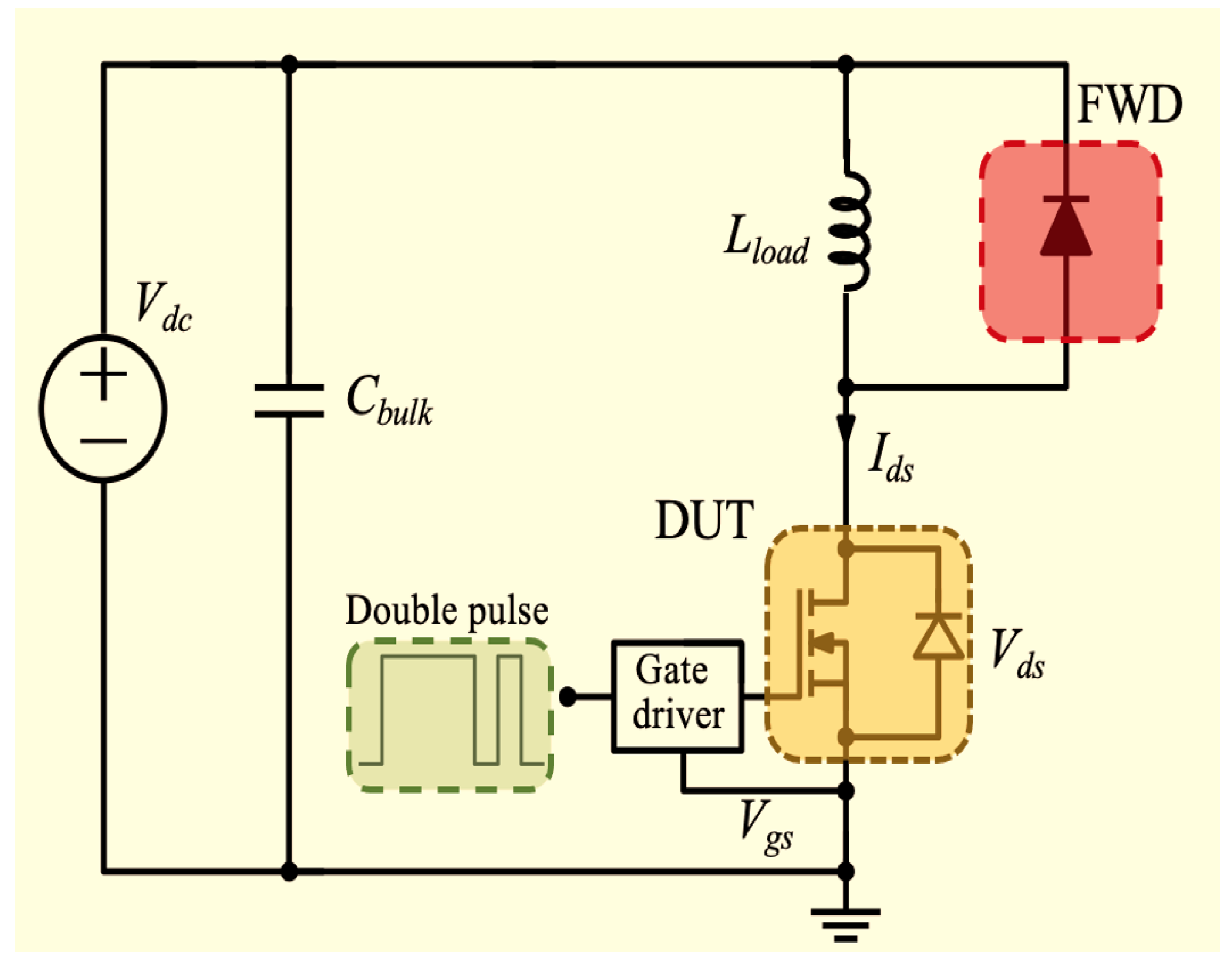

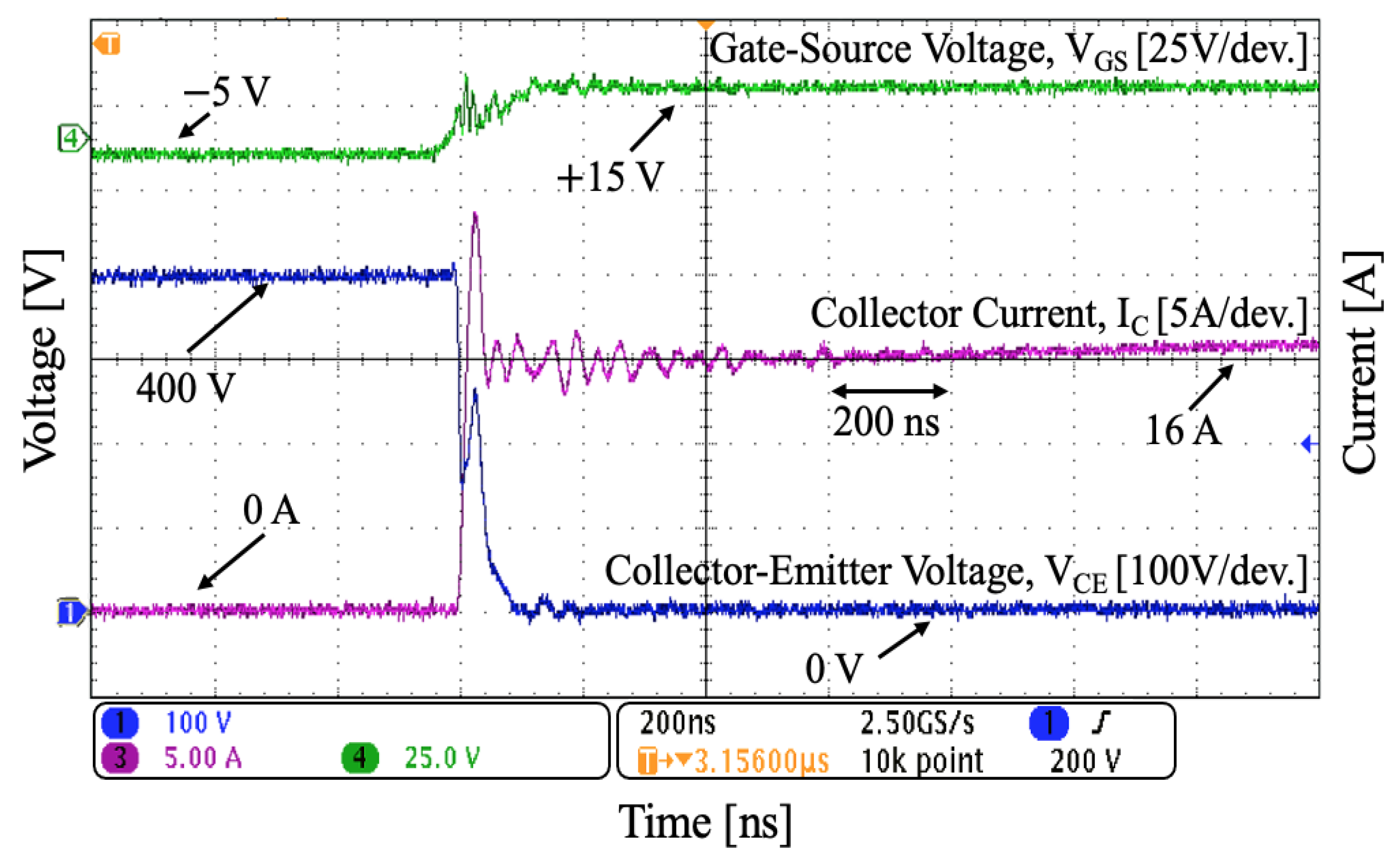
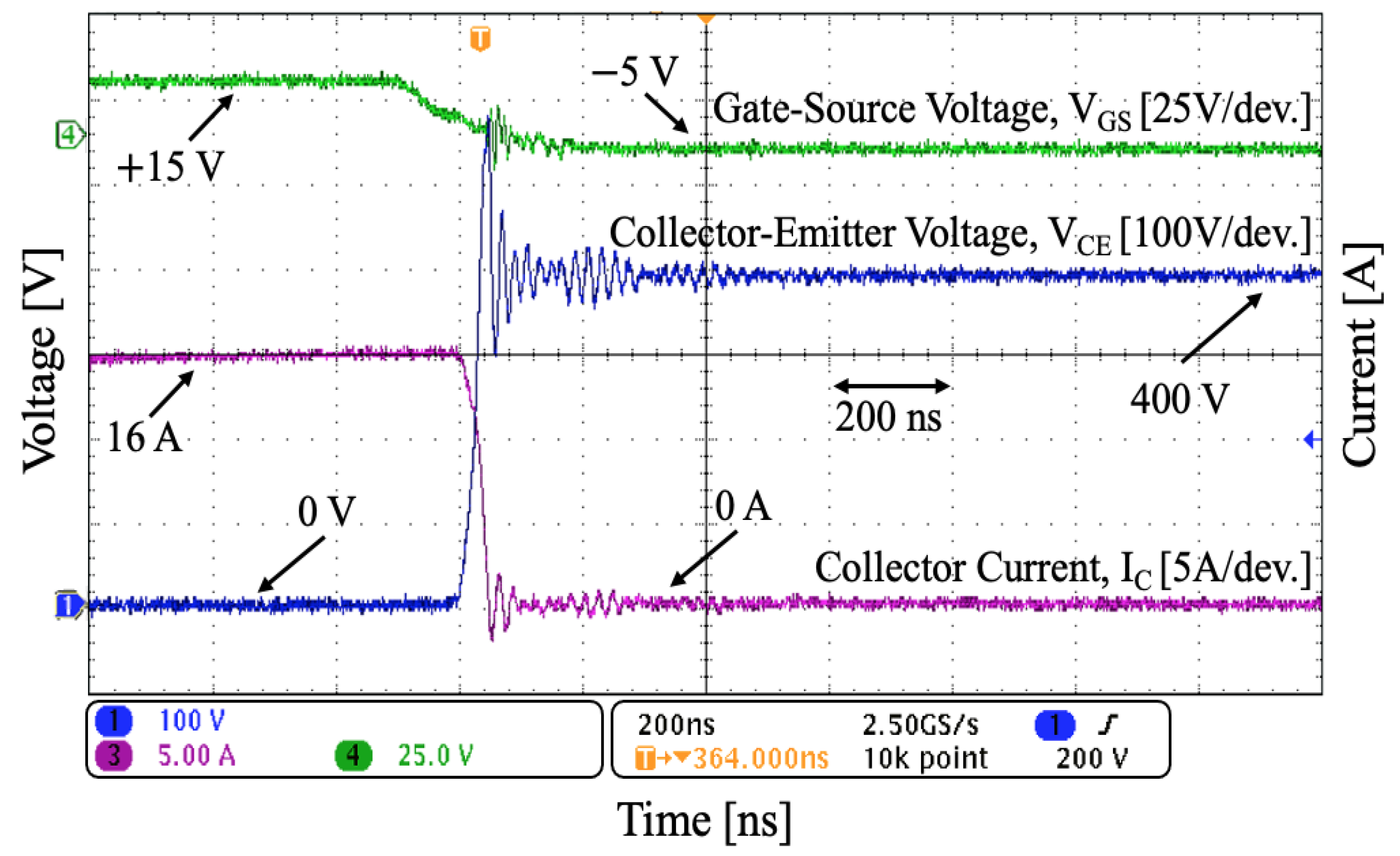
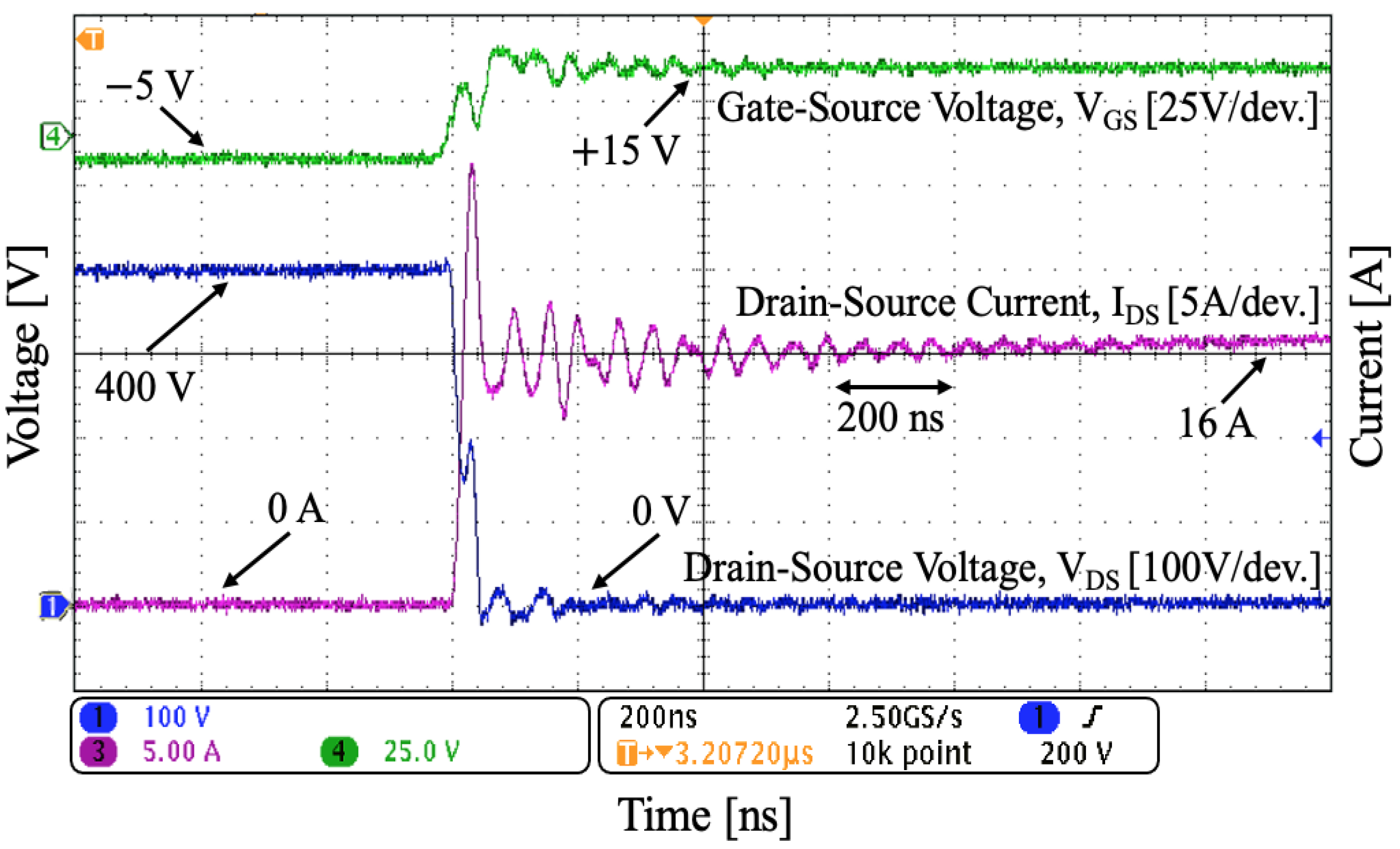
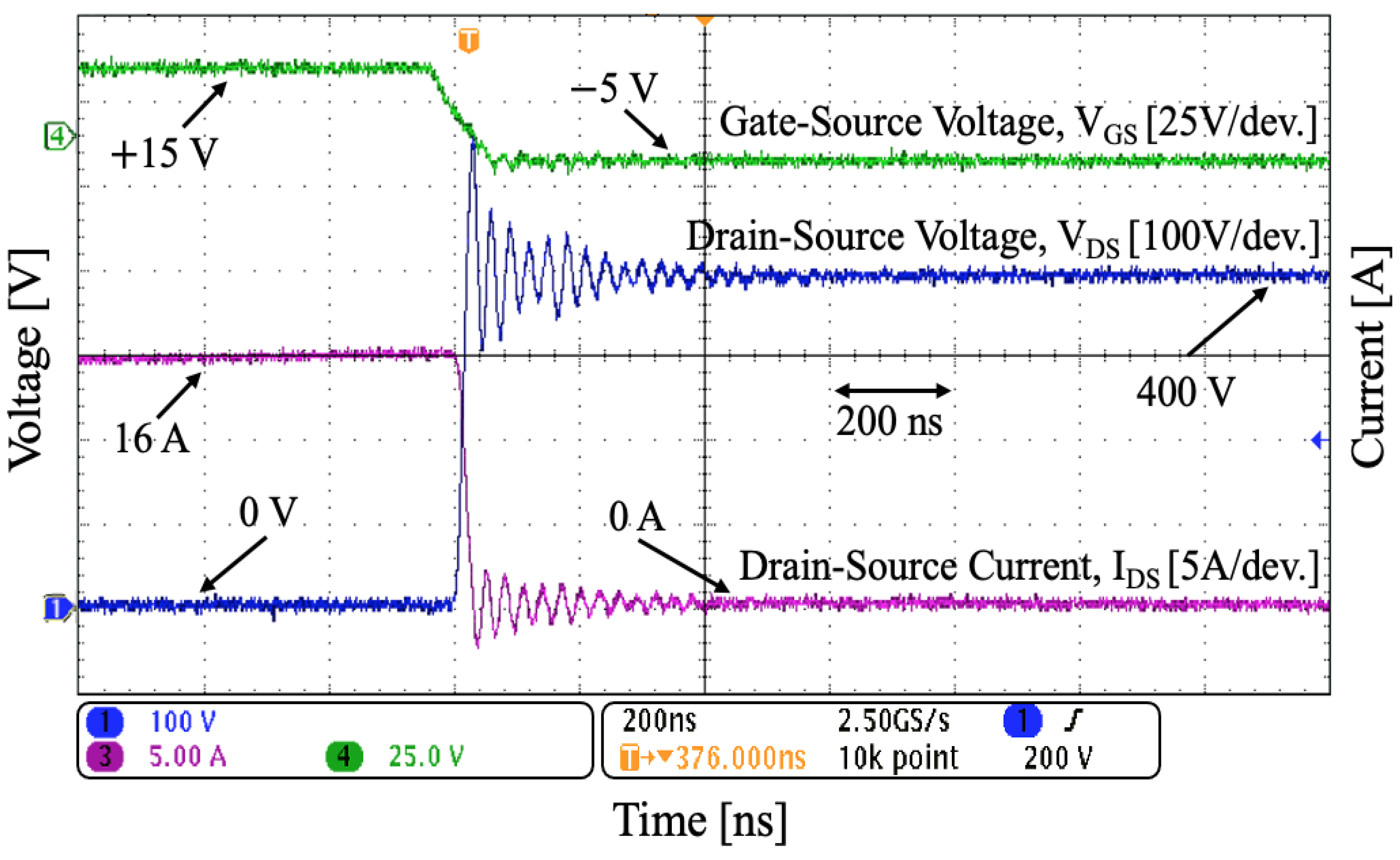
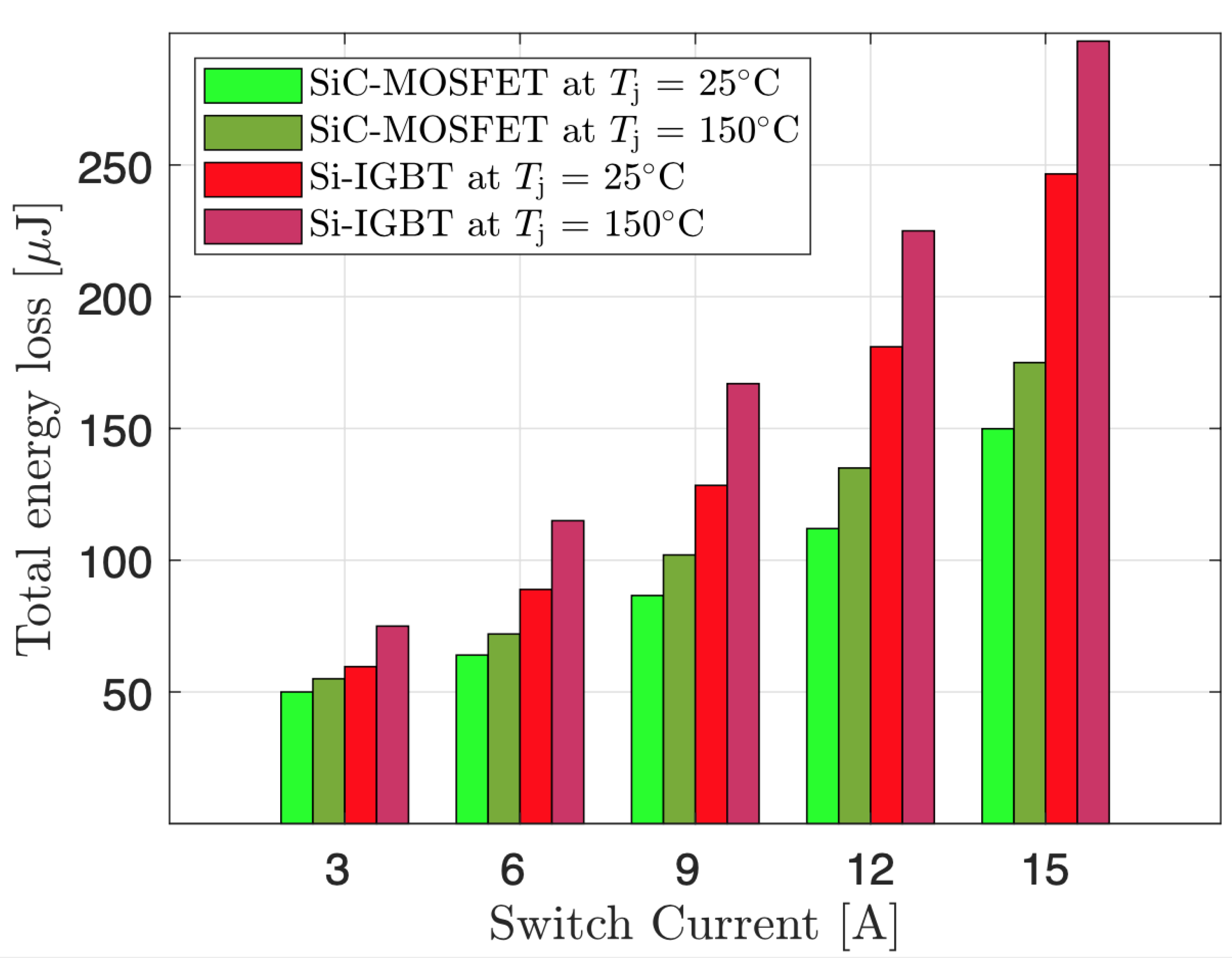
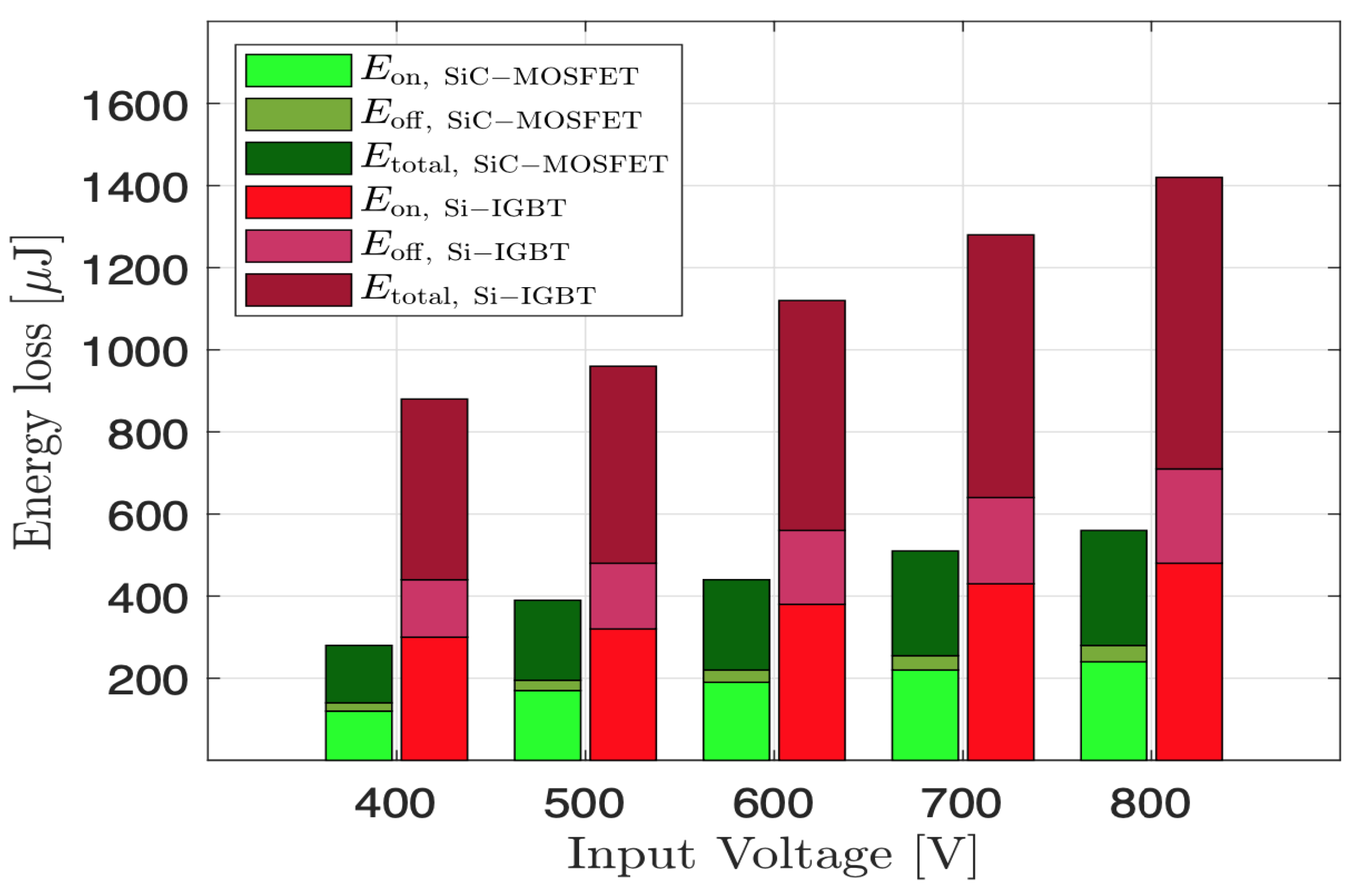

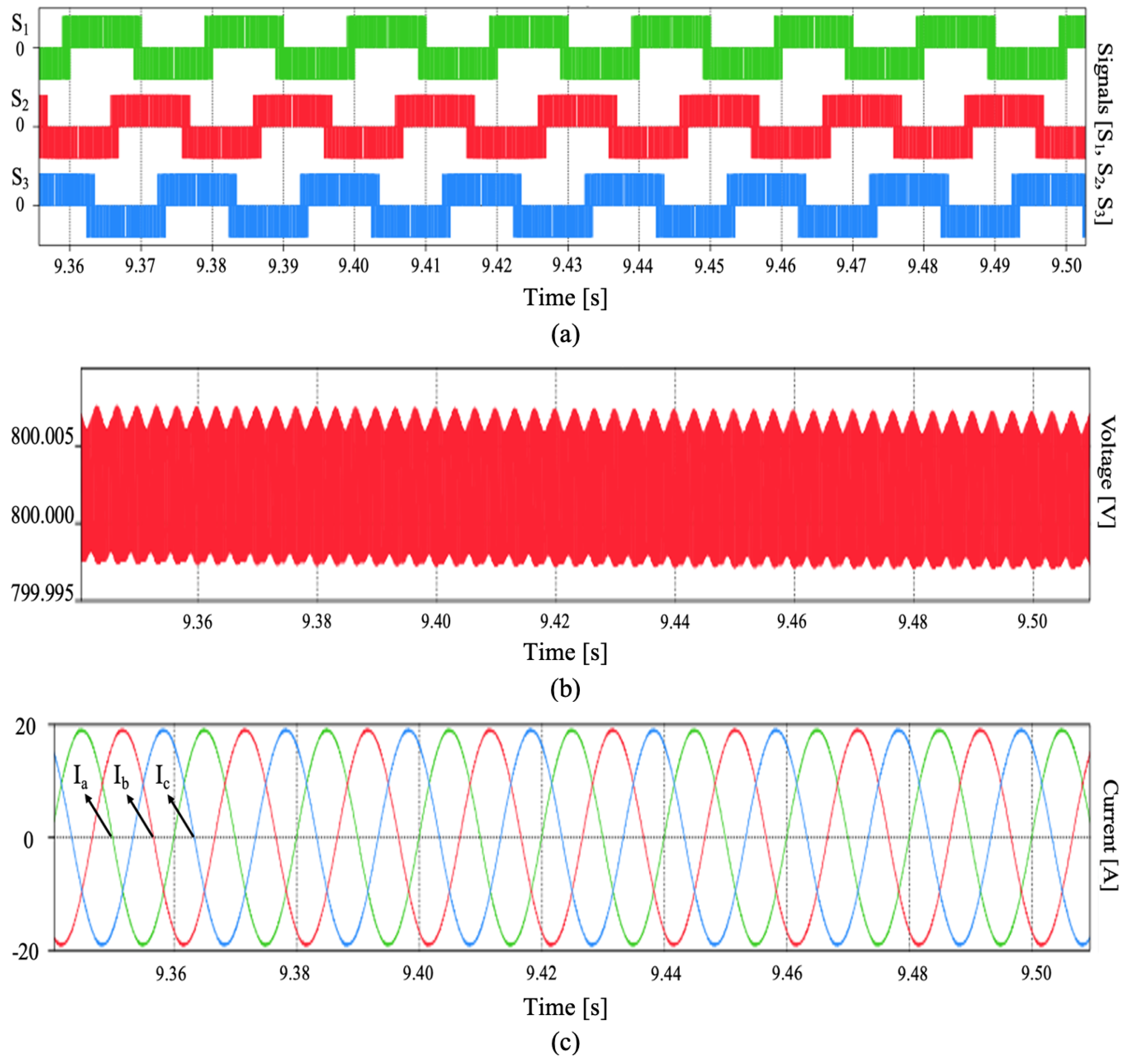
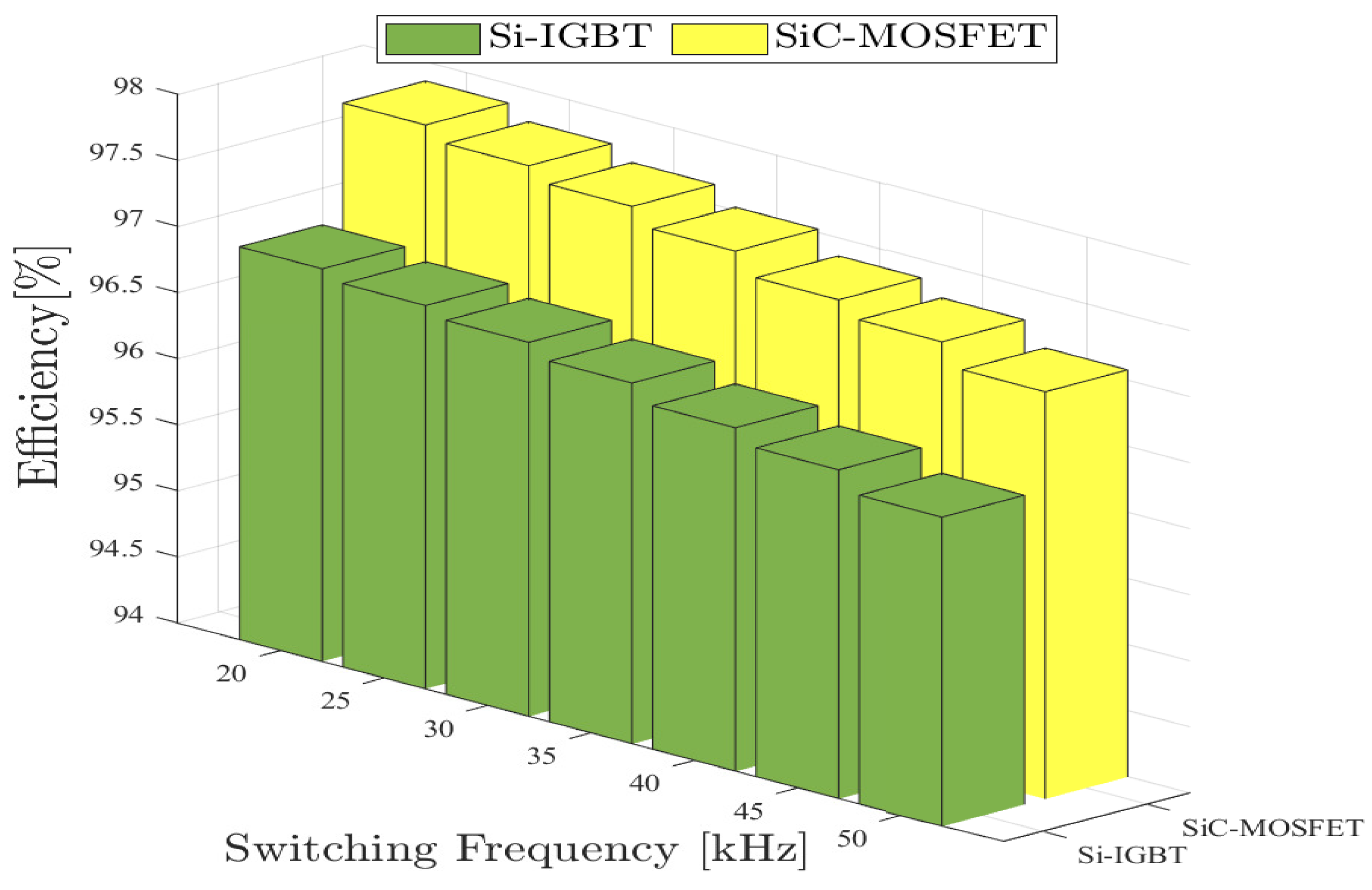
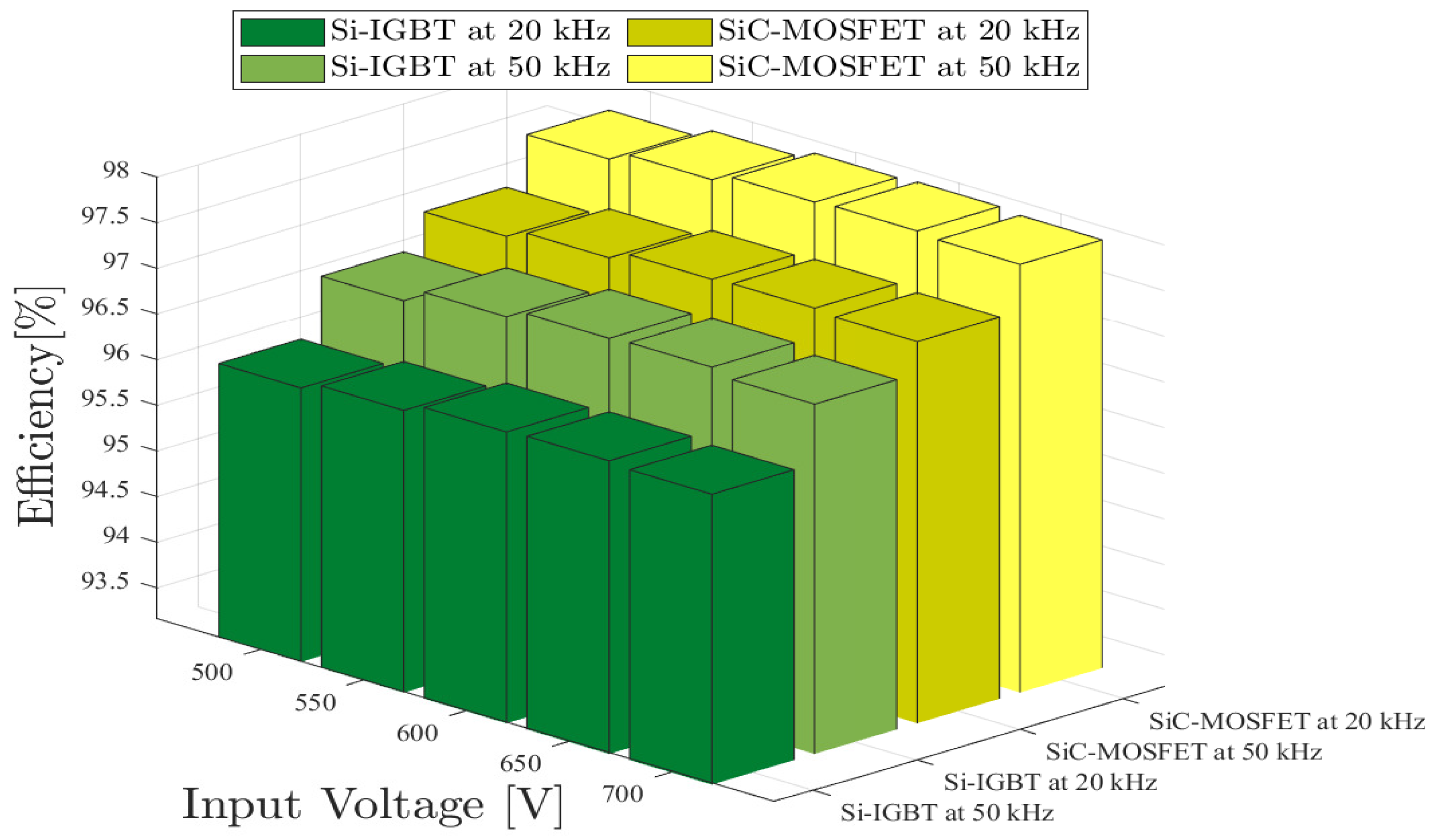
| Electrical Parameters | Si-IGBT | SiC-MOSFET |
|---|---|---|
| Part number | IXYH24N90C3D1 | C3M0065090D |
| Blocking voltage | 900 V | 900 V |
| Gate-source voltage | ±30 V | –8/+19 V |
| Continuous current | 44 A | 36 A |
| (@ 25 °C) | 2.3 V | – |
| (@ 25 °C) | – | 65 m |
| Junction temperature | 150 °C | 150 °C |
| Equipment | Specification |
|---|---|
| Digital oscilloscope (DPO3014) | 100 MHz, 4 channels |
| Waveform generator (33500B) | 30 MHz, 2 channels |
| Voltage differential probe (P5200A) | 50 MHz, 50X/500X with deskew of 11.6 ns |
| Pearson current monitor (2878) | 1 Volt/Ampere +1/−0% with deskew of 0 ns |
| Hot plate magnetic (MS300) | up to 300 °C |
| Power supply (N8937A) | 15 kW |
| DC capacitor (R75PR4100AA30K) | 20 F |
| Inductive load | 470 H |
| Si-IGBT | SiC-MOSFET | |||
|---|---|---|---|---|
| Current (A) | (J) | (J) | (J) | (J) |
| 3 | 40.4 | 19.2 | 35.6 | 14.4 |
| 6 | 55.6 | 33.3 | 46.8 | 17.2 |
| 9 | 78.8 | 49.6 | 64.3 | 22.3 |
| 12 | 114.6 | 66.4 | 81.2 | 30.8 |
| 15 | 164.5 | 82.1 | 110 | 39.9 |
| Total Energy Loss of Si-IGBT (μJ) | Total Energy Loss of SiC-MOSFET (μJ) | |||
|---|---|---|---|---|
| () | at 25 °C | at 150 °C | at 25 °C | at 150 °C |
| 5 | 59.6 | 73.6 | 50 | 65.1 |
| 10 | 88.9 | 153.2 | 64.1 | 101.3 |
| 15 | 148 | 269.8 | 88.6 | 146.4 |
| 20 | 220.2 | 411.2 | 119.4 | 173.5 |
| 25 | 288.7 | 529.4 | 132.4 | 249.8 |
| Parameters | Symbol | Value |
|---|---|---|
| Input DC voltage | 700 V | |
| Output power | 3 kW | |
| Grid frequency | 50 Hz | |
| Grid voltage | 230 V | |
| Switching frequency | 100 kHz |
Disclaimer/Publisher’s Note: The statements, opinions and data contained in all publications are solely those of the individual author(s) and contributor(s) and not of MDPI and/or the editor(s). MDPI and/or the editor(s) disclaim responsibility for any injury to people or property resulting from any ideas, methods, instructions or products referred to in the content. |
© 2025 by the authors. Licensee MDPI, Basel, Switzerland. This article is an open access article distributed under the terms and conditions of the Creative Commons Attribution (CC BY) license (https://creativecommons.org/licenses/by/4.0/).
Share and Cite
Alharbi, S.S.; Alharbi, S.S.; Bubshait, A.; Alharbi, H.; Alateeq, A. Effects of Wide Bandgap Devices on the Inverter Performance and Efficiency for Residential PV Applications. Electronics 2025, 14, 1061. https://doi.org/10.3390/electronics14061061
Alharbi SS, Alharbi SS, Bubshait A, Alharbi H, Alateeq A. Effects of Wide Bandgap Devices on the Inverter Performance and Efficiency for Residential PV Applications. Electronics. 2025; 14(6):1061. https://doi.org/10.3390/electronics14061061
Chicago/Turabian StyleAlharbi, Saleh S., Salah S. Alharbi, Abdullah Bubshait, Hisham Alharbi, and Abdulaziz Alateeq. 2025. "Effects of Wide Bandgap Devices on the Inverter Performance and Efficiency for Residential PV Applications" Electronics 14, no. 6: 1061. https://doi.org/10.3390/electronics14061061
APA StyleAlharbi, S. S., Alharbi, S. S., Bubshait, A., Alharbi, H., & Alateeq, A. (2025). Effects of Wide Bandgap Devices on the Inverter Performance and Efficiency for Residential PV Applications. Electronics, 14(6), 1061. https://doi.org/10.3390/electronics14061061






